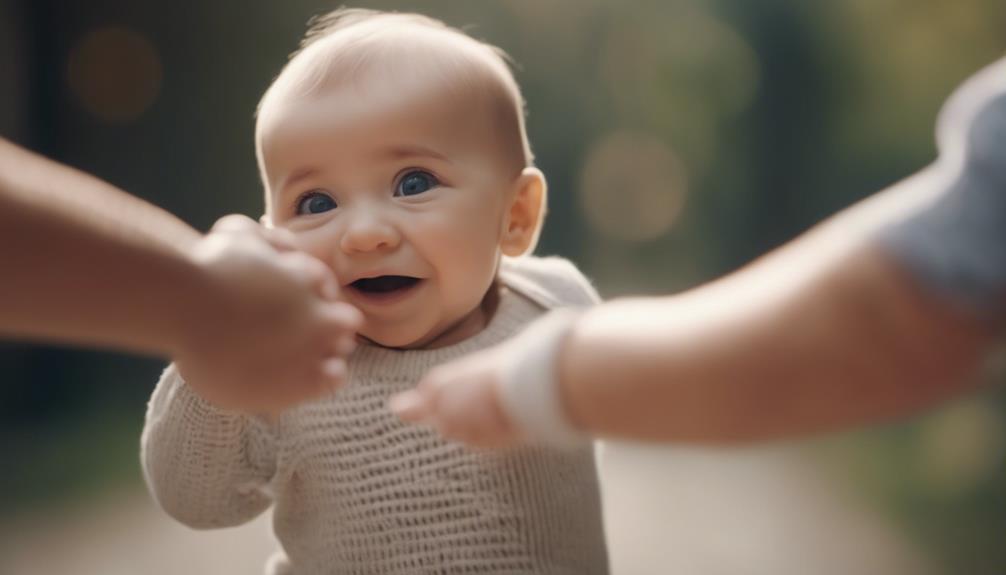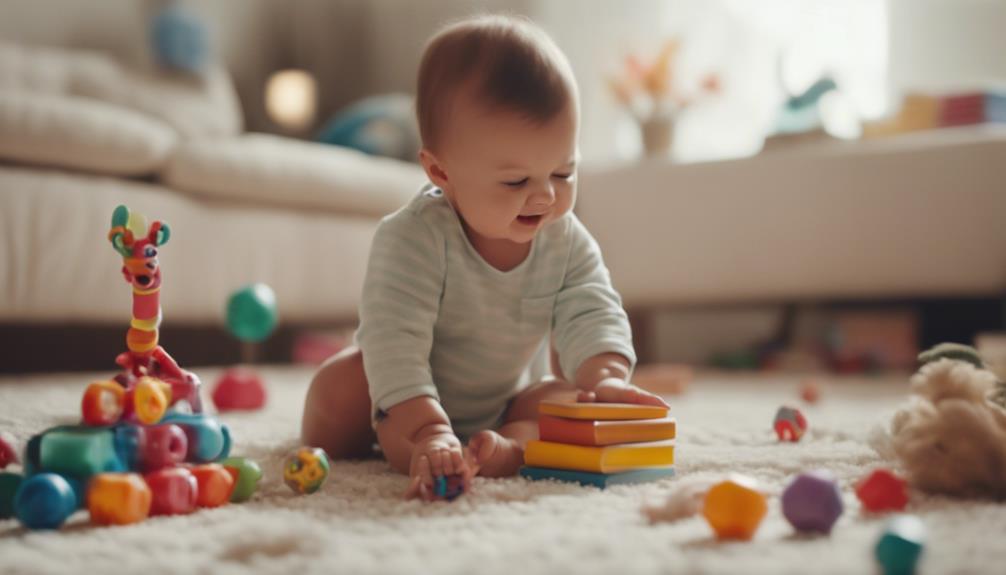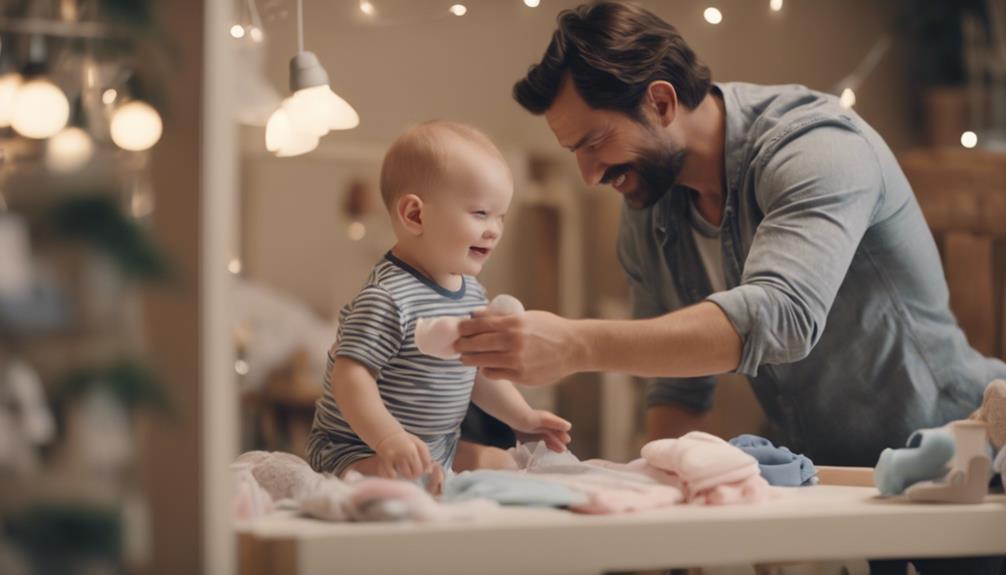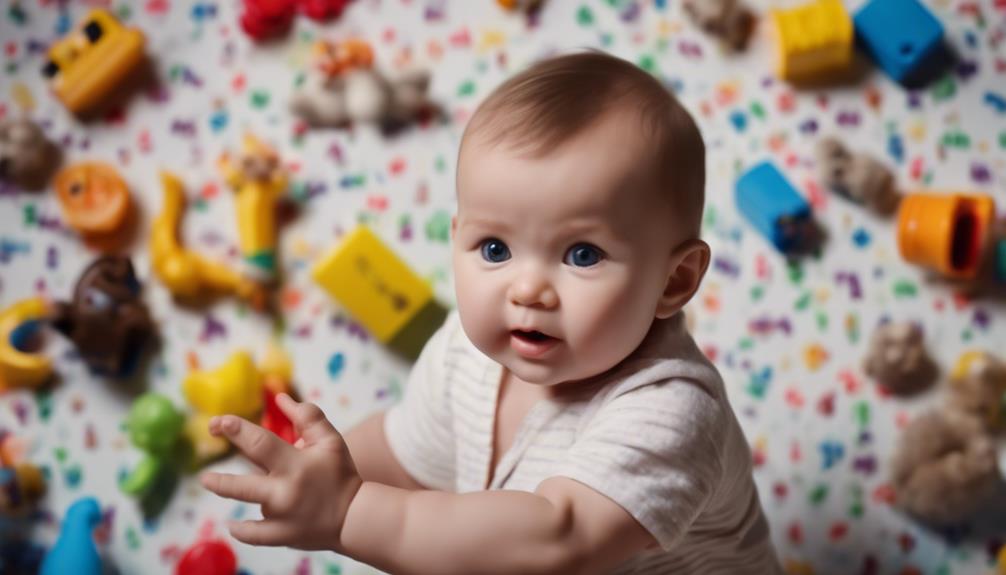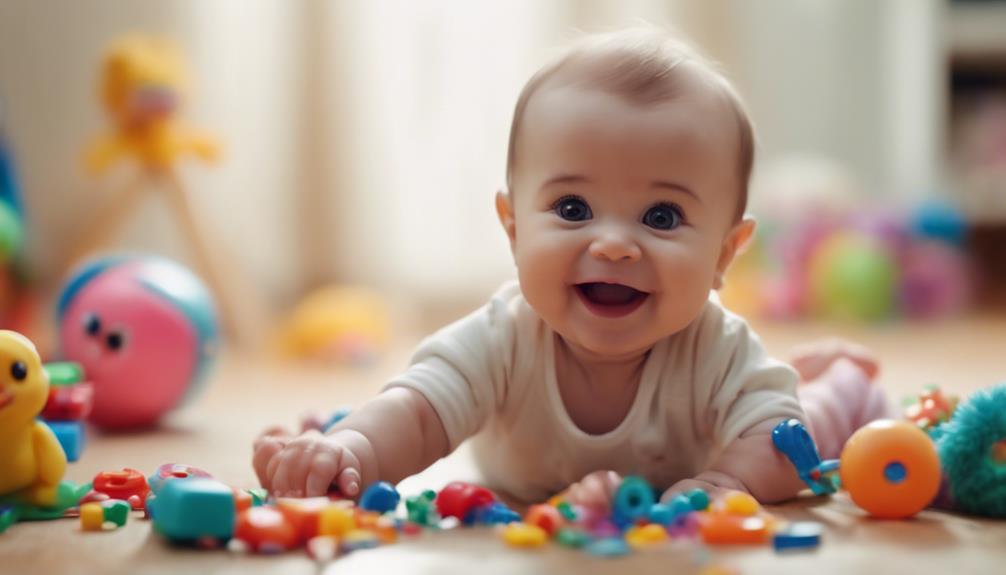When your baby looks into your eyes, it’s a sign of love and connection. Cuddles and snuggles provide comfort and security, helping to build a strong bond. Smiles and laughter shared between you both enhance your emotional connection. The sheer joy your baby exhibits when seeing you is a clear demonstration of attachment. Seeking comfort in your arms displays love and trust, fostering a deep bond. Pay attention to coos and babbles, as they communicate happiness and affection. Separation anxiety may indicate a strong emotional bond with you. Look out for affectionate gestures, such as mimicking kisses, as they demonstrate love. Remember to regularly check in, responding with love and reassurance.
Key Takeaways
- Maintains prolonged eye contact, expressing affection and attachment.
- Laughs and smiles joyfully in response to you.
- Seeks comfort and closeness through cuddles and snuggles.
- Shows excitement and happiness upon seeing you.
- Responds eagerly to your voice, gestures, and presence.
Eye Contact
Babies express their love by making meaningful eye contact with their caregivers, establishing a strong emotional bond from a very young age. When your little one locks eyes with you, they aren't just gazing aimlessly; they're forming a connection that speaks volumes without words.
This eye contact is a powerful tool for building trust and security between you and your baby. As early as a few weeks old, babies show a preference for familiar faces, especially their parents, through this visual interaction. It's a beautiful way for them to convey their love and recognition of you.
Cuddles and Snuggles
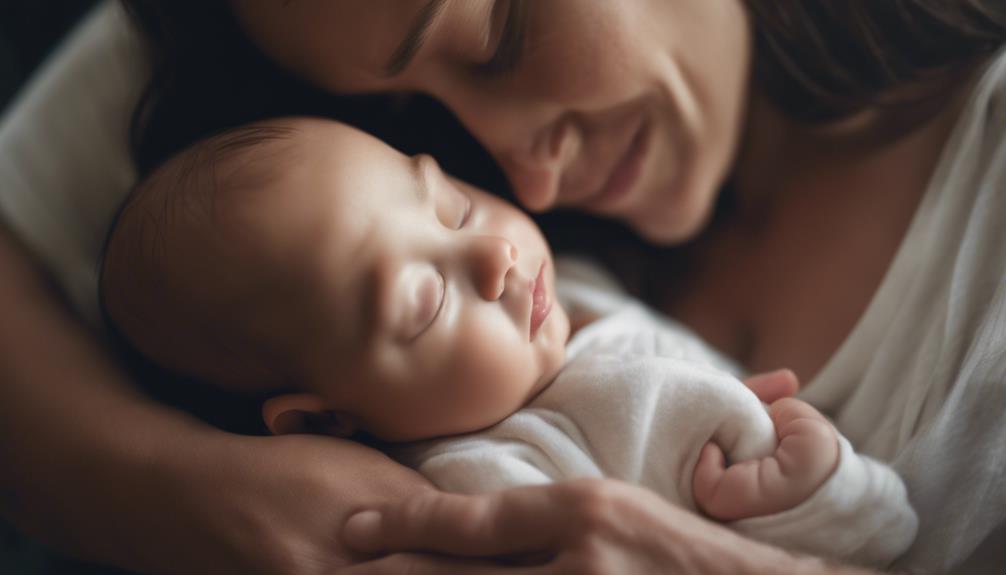
Seeking comfort and security, your little one expresses love through cuddles and snuggles with you, fostering a strong emotional bond. These moments of physical affection are not just about warmth; they are powerful indicators of the deep connection your baby feels towards you. When your baby nestles close to you, they are seeking more than just a cuddle; they are seeking reassurance, safety, and a sense of belonging.
To help you understand the significance of these cuddles and snuggles, here is a table highlighting how these gestures reflect your baby's love and attachment:
| Cuddles and Snuggles | Significance |
|---|---|
| Seeking Comfort | Your baby finds solace and security in your embrace. |
| Emotional Bond | Cuddling strengthens the emotional connection between you both. |
| Feeling Safe | Snuggling close makes your baby feel protected and loved. |
| Love Hormone Release | Cuddles release oxytocin, deepening the bond between you. |
| Attachment Indicator | Your baby's preference for cuddles shows their love for you. |
Embrace these moments of closeness; they are not just gestures but the language of love between you and your baby.
Smiles and Laughter
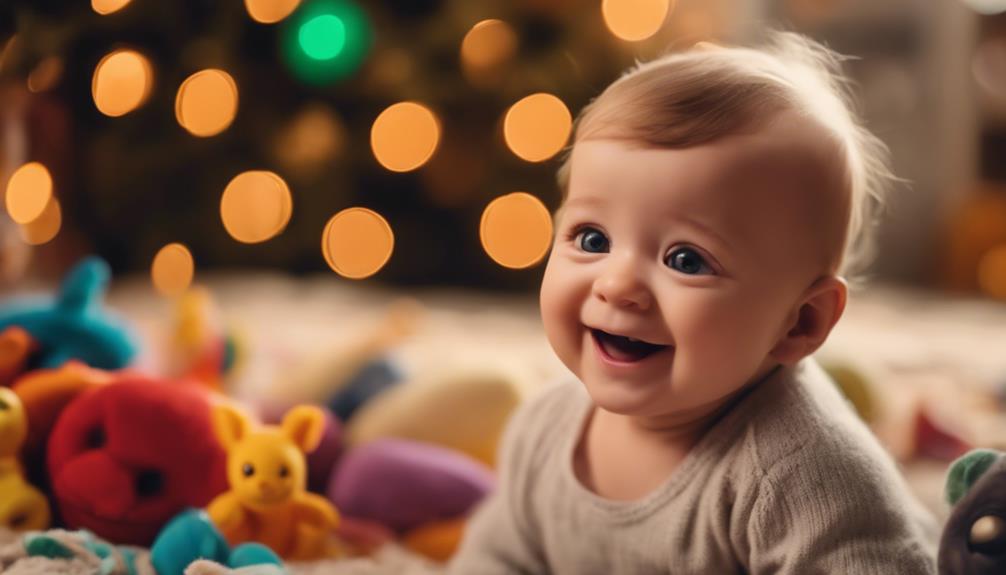
Experiencing your baby's first social smile around 6-8 weeks old is a heartwarming indication of their love and connection to you. When your little one smiles and laughs in your presence, it's a beautiful display of their affection and joy. Here are some heartening signs to look out for:
- Mutual Smiling: Sharing smiles with your baby strengthens your bond and shows their love for you.
- Laughter Response: Your baby's laughter in response to your actions or mere presence is a delightful sign of their affection and happiness.
- Playful Interactions: Encouraging playful moments that lead to laughter not only bring joy but also deepen the emotional connection between you and your baby.
Excitement Upon Seeing You
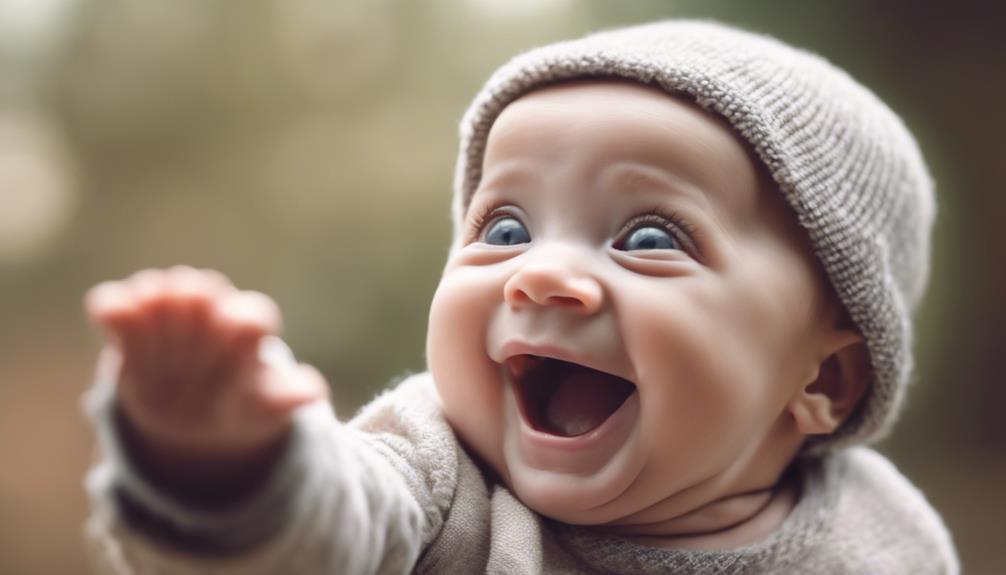
Upon your arrival, a burst of genuine excitement and happiness lights up your baby's face, reflecting the deep bond and attachment they feel towards you. It's truly heartwarming to see your little one's eyes light up, their arms reaching out enthusiastically as they express their joy at seeing you.
This genuine excitement is a clear indication of the strong emotional connection your baby feels towards you. As a parent, you play an essential role in evoking these beautiful reactions from your baby. Their joyful response when they see you is a pure display of love and attachment.
These moments of excitement upon reuniting with your precious one demonstrate the depth of their feelings. Cherish these special moments, as they're a reminder of the unique bond you share with your baby. Your presence brings immense happiness to your little one, and their excitement upon seeing you is a confirmation of the love they have for you.
Seeking Comfort From You
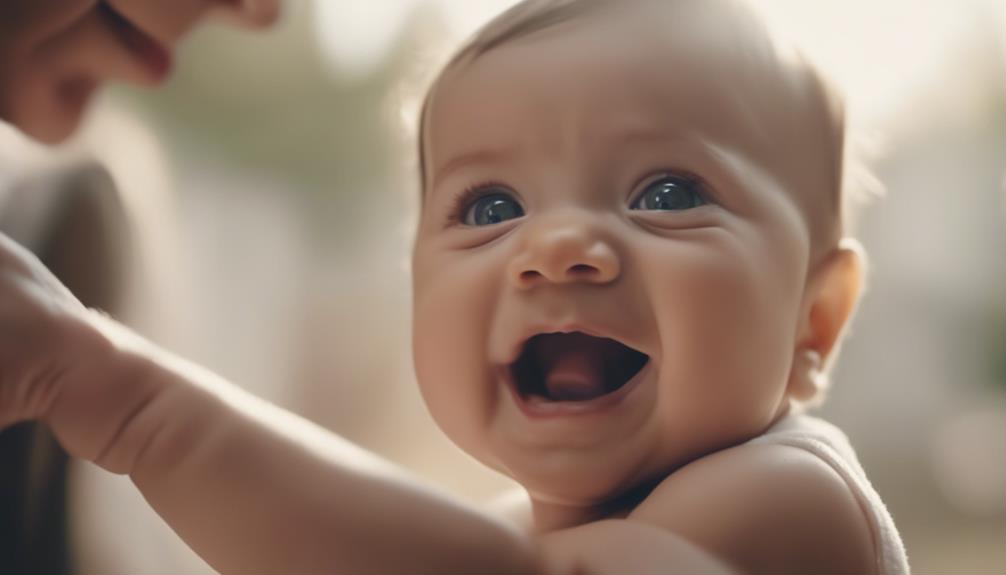
When your baby clings to you for comfort, it's a beautiful sign of their love and trust in you.
They reach out for hugs and closeness because they feel safe and secure in your arms.
Clingy for Comfort
Your baby's clinginess for comfort is a clear indicator of their attachment and trust in you. When your little one seeks solace in your arms, it's a heartwarming sign of the bond you share.
Here are some ways to understand and cherish these moments:
- Embrace the Closeness: Your baby's clingy behavior is a natural way of expressing their need for security and love. Embrace these moments to strengthen your connection and provide the comfort they seek.
- Offer Reassurance: When your baby is clingy, it may be because they're feeling overwhelmed or insecure. By offering reassurance through your presence and touch, you're creating a safe space for them to find comfort.
- Build Trust: Responding to your baby's need for comfort builds a foundation of trust. This trust forms the basis of a secure attachment, fostering emotional well-being and a sense of security in your child.
Reaches Out to You
Embracing your baby's natural inclination to reach out to you for comfort is a heartwarming way to nurture your bond and meet their emotional needs. When your little one extends their arms towards you, it's more than just a physical gesture; it's a profound display of love and trust. Babies, around six months old, often use this non-verbal cue to seek the warmth and security of your embrace.
By reaching out for hugs or to be picked up, your baby is expressing their need for physical comfort and connection with you.
Responding to your baby's reach with love and affection not only provides them with the comfort they seek but also reinforces the strong bond between you. This simple act of reaching out signifies their attachment to you and their reliance on your emotional support.
Mimicking Your Expressions
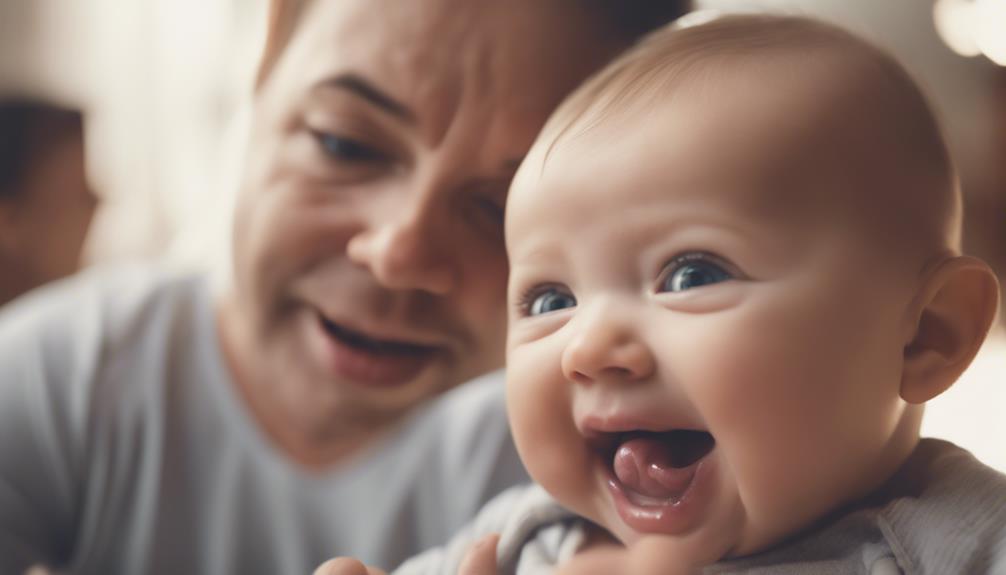
By mimicking your facial expressions, babies learn and bond with caregivers in a natural and affectionate way. When your little one mirrors your smiles, frowns, or other gestures, it's a heartwarming sign of their love and connection with you.
This mirroring behavior isn't just adorable; it's a fundamental way for them to understand emotions and build a strong relationship with you.
Here are three ways babies expressing love through mimicking can be observed:
- Creating a Strong Emotional Bond: When your baby imitates your facial expressions, it shows a deep emotional connection and a desire to communicate with you.
- Learning Affection: Mimicking your actions helps babies comprehend expressions of love, fostering a loving and caring environment.
- Expressing Desire for Connection: Watching your baby copy gestures like kissing can be a clear indication of their desire to connect and show affection.
Coos and Babbles
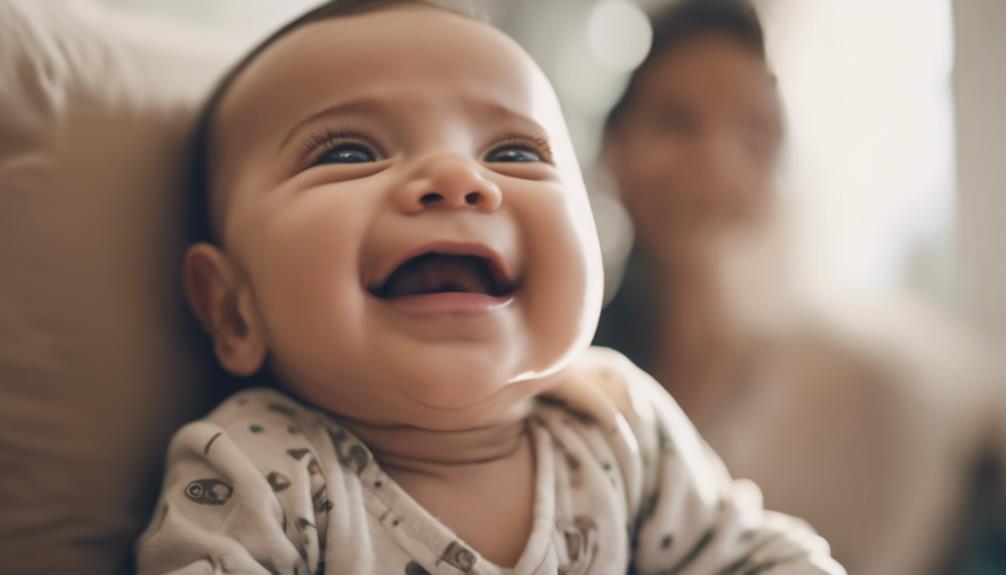
Mimicking your facial expressions is just one way your baby communicates their love; another significant avenue is through coos and babbles. From around 2-3 months old, your little one starts using these adorable sounds to connect with you.
Engaging in conversations with your baby through coos and babbles isn't just essential; it's vital for their development. By listening attentively and responding to their verbal cues, you're helping them build essential communication skills. Encouraging these verbal interactions teaches your baby how to express their love and emotions, laying a strong foundation for future relationships.
Creating a supportive and loving environment for communication is key. Responding enthusiastically to their babbles shows that you value what they've to say, boosting their confidence.
Separation Anxiety
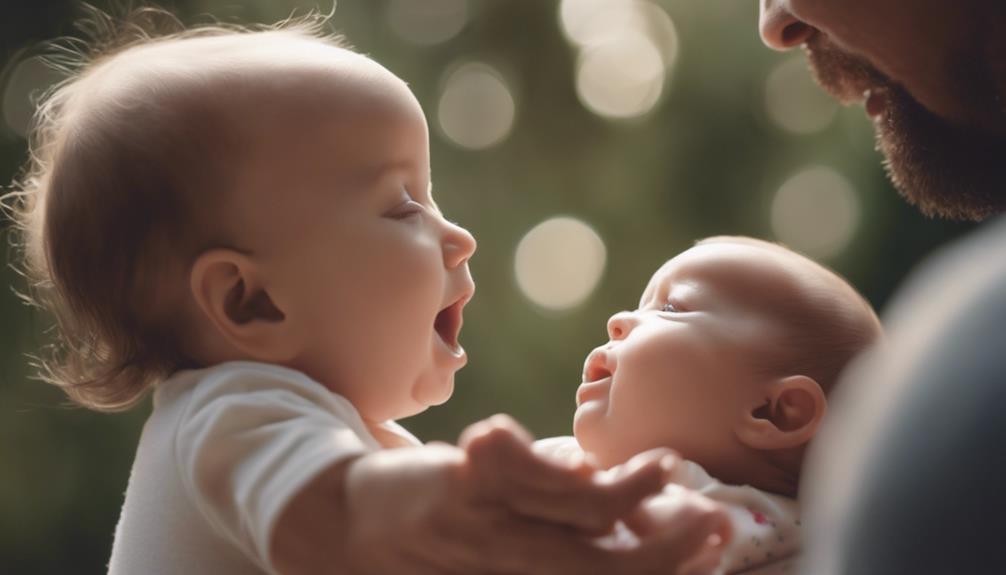
As your baby grows, you may notice signs of separation anxiety emerging around 6-8 months of age. When separated from you, your baby might display distress through crying, a natural part of their emotional development.
Signs of Attachment
Experiencing separation anxiety around 6-8 months is a clear indication of your baby's strong attachment and love for you as their primary caregiver. During this time, your baby may show signs of attachment through:
- Crying or distress: When your baby expresses distress or cries upon separation, it signifies their emotional bond and reliance on you for comfort and security.
- Seeking reassurance: Your baby seeking comfort and reassurance from you during separations demonstrates their love and trust in your presence.
- Temporary distress: Temporary distress during separations highlights the depth of your baby's attachment and their need for your emotional support.
Understanding these signs can help you navigate this phase with patience and reassurance. Your baby's expressions of separation anxiety are a normal part of their development, showcasing the strong bond and love they've for you.
Emotional Reactions Observed
During separations, babies often exhibit emotional reactions such as crying or fussiness as a sign of their attachment and reliance on their caregiver for comfort and security. Separation anxiety typically emerges around 6-8 months of age, marking an important phase in their emotional development.
When your baby shows distress at being apart from you, it's a clear indication of the strong bond and trust they've in you as their caregiver. Reassuring your baby during these moments not only provides comfort but also helps strengthen the foundation of security in your relationship.
Comfort-Seeking Behaviors
When your baby experiences separation anxiety, they may exhibit comfort-seeking behaviors to express their attachment and trust in you as their caregiver.
Here are some signs to look out for:
- Clings to You: Your baby might cling to you when you try to leave, seeking physical closeness for security.
- Cries When Separated: Tearful goodbyes or crying when you're out of sight are common reactions during separation anxiety.
- Seeks Reassurance: Your baby may seek comfort through your touch, voice, or familiar objects to feel secure in your presence.
Understanding these comfort-seeking behaviors is essential in supporting your baby through separation anxiety. By responding with love and reassurance, you're helping them build emotional security and trust in your bond.
Affectionate Gestures
You can recognize your baby's love through their affectionate gestures, such as mimicking kissing behaviors they observe. When your little one starts puckering up for a kiss or giving you those big, slobbery smooches around their first year, it's a clear sign that they're trying to show their love and attachment to you.
Those mouth-open kisses they plant on your cheek or nose aren't just adorable; they also reveal their growing understanding of affection and connection. These affectionate gestures like kissing and hugging are ways babies learn to express their love and strengthen the bond with their caregivers.
Checking In
Seeking reassurance and connection, babies often check in frequently with their caregivers, demonstrating their attachment and trust. When your baby looks to you for comfort and safety through these check-ins, it's a heartwarming sign of the bond you share.
Here are some ways babies show their love by checking in:
- Eye Contact: Your baby may lock eyes with you, seeking reassurance and connection.
- Reaching Out: Babies might reach their arms out towards you, signaling their need for comfort and security.
- Vocalizations: From cooing to babbling, your little one may make sounds to communicate and check in with you.
Frequently Asked Questions
How Do You Know if Your Baby Feels Loved?
You know your baby feels loved when they smile at you, seek cuddles, show excitement upon seeing you, reach out for you, turn towards your voice, and display separation anxiety when you leave.
How Can I Tell if My Baby Loves Me?
You can tell if your baby loves you by the way they smile, gaze into your eyes, and seek physical affection. Communication cues like cooing and babbling, reaching out for hugs, and seeking comfort all show their affection for you.
How to Tell if Baby Trusts You?
To tell if your baby trusts you, look for signs like seeking comfort in challenging moments, showing excitement when you return, and displaying separation anxiety when you leave. These actions demonstrate the bond between you.
Can Babies Feel the Love You Give Them?
Yes, babies can feel the love you give them. Your nurturing touch, soothing voice, and responsive interactions create a positive bond. They show love through seeking comfort, smiling, and reaching out. Maintain a secure and loving environment for a strong emotional connection.
Conclusion
So keep an eye out for these signs, and cherish every moment of love and connection with your baby.
Remember, they may not be able to say 'I love you' yet, but their actions speak volumes.
Can you imagine the joy and warmth that comes from knowing your baby loves you just as much as you love them?
Trust in these heartwarming clues and enjoy the beautiful bond you share with your little one.

